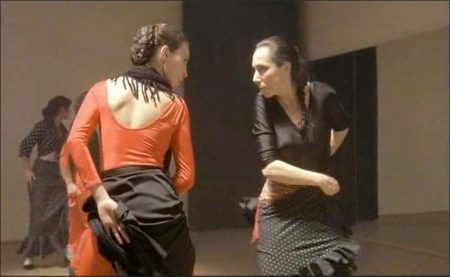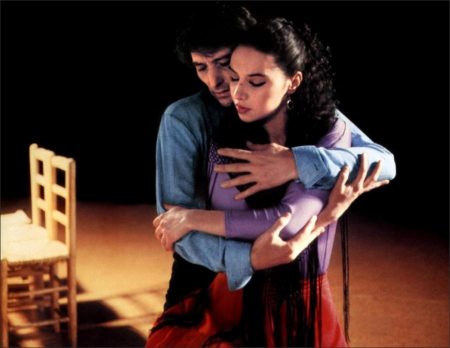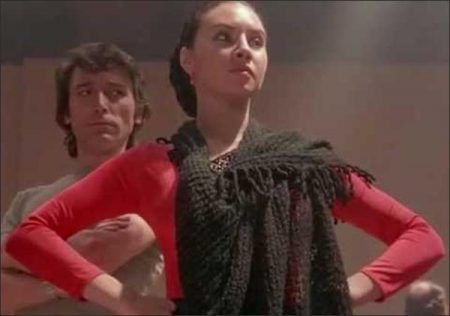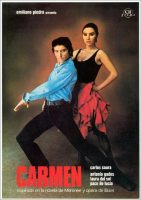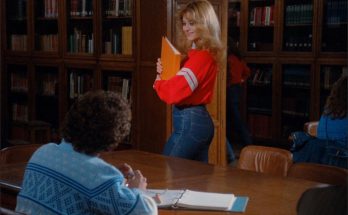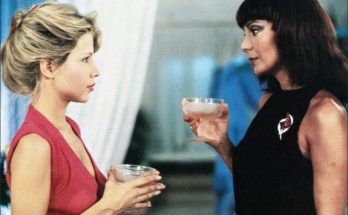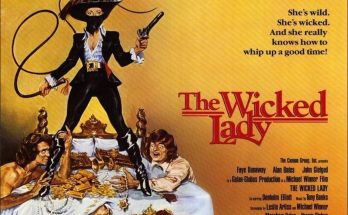Carmen movie storyline. A group of flamenco dancers are rehearsing a very spanish version of the Prosper Merimee’s drama. Antonio (the coreographer) falls in love with Carmen (the main dancer). Their story then turns similar to the play.
Carmen is a 1983 Spanish film adaptation of the novel Carmen by Prosper Mérimée, using music from the opera Carmen by Georges Bizet. It was directed and choreographed in the flamenco style by Carlos Saura and María Pagés. It is the second part of Saura’s flamenco trilogy in the 1980s, preceded by Bodas de sangre and followed by El amor brujo.
The film’s basic plot line is that the modern dancers re-enact in their personal lives Bizet’s tragic love affair, up to its lethal climax, starring by Paco de Lucía, Laura del Sol, Antonio Gades, Marisol, Cristina Hoyos, Juan Antonio, José Yepes and Sebastián Moreno.
Review: Carmen by Carlos Saura
AS saucy, wanton, inexhaustible femme fatales go, Carmen, the Spanish gypsy who first appeared in Prosper Merimee’s 1845 novel, must be one of the most popular and long-lived. Principally responsible, I suppose, is the continuing popularity of Bizet’s 1874 opera. That ”Carmen” goes on and on and on, whether conventionally performed, as it’s done in most of the world’s opera houses, or whether ”adapted,” as in Rodgers and Hammerstein’s ”Carmen Jones” and in Peter Brooks’s production ”Carmen,” which will open shortly in the Vivian Beaumont Theater.
Since 1915, when Geraldine Farrar, the American soprano, appeared in a silent-movie version, ”Carmen” has turned up fairly regularly on movie screens. Among the various incarnations have been the 1946 French film with Viviane Romance, the 1948 version (”The Loves of Carmen”) with Rita Hayworth, Otto Preminger’s screen version of ”Carmen Jones” (1954) and, in 1968, Radley Metzger’s ”Carmen Baby,” a made-in-Yugoslavia exploitation film with rock music standing in for Bizet’s score.
One of the best of these very free adaptations must be Carlos Saura’s flamenco ”Carmen,” which opens today at the Plaza Theater. Conceived by Mr. Saura and Antonio Gades, the famed dancer-choreographer and former director of the National Ballet of Spain, this ”Carmen” combines dance, Bizet music and a modern if very slim narrative to find its own contemporary equivalent to the passionate 19th-century grandeur of the opera.
Mr. Saura, who directed the film, and Mr. Gades, who choreographed it and plays a central role, use as the frame of their film the story of a dance company rehearsing ”Carmen,” a production that seems to be as freely conceived as the film itself.
The search for the perfect leading lady turns up a beautiful, dark-haired young dancer named, coincidentally, Carmen (Laura Del Sol). In the course of practice sessions and rehearsals, Antonio (Mr. Gades), the troupe’s director, choreographer and leading male dancer, falls in love with his star. When it comes to men, this Carmen’s attention span is just as short as that of the Merimee character.
The contemporary frame is not great and, by the time the movie is approaching its supposedly tragic climax, it has become quite awful. Miss Del Sol has a sultry screen presence, but her modern-day Carmen doesn’t seem wicked or driven enough to create the sort of mayhem necessary. The parallels between the contemporary story and Merimee’s don’t work for a minute.
However, a lot of the other things do. Virtually the entire film is set in a large rehearsal hall in which Antonio and his dancer-singers, in practice clothes, go through the key scenes of their production, dancing sometimes to Bizet music – taken from a recording of the opera starring Regina Resnick and Mario Del Monaco – and sometimes to flamenco music provided by the troupe’s own musicians.
In this way the film serves up bits and pieces of the opera to surprisingly moving effect. There’s a riveting sequence near the start of the movie when Paco De Lucia, the guitarist in the movie as he is in life, adapts a Bizet melody to become a flamenco lament. The opera’s fight between Carmen and another woman, who also works in the cigarette factory, becomes a dance of the sort of blinding vicious energy that one seldom ever encounters in an opera house. In this way, too, Mr. Saura succeeds in rediscovering many of the emotions that may elude today’s opera audiences.
Miss Del Sol, Mr. Gades and Cristina Hoyos, who plays a leading dancer in Antonio’s company as well as Carmen’s rival at the cigarette factory, are so fine dancing their uncostumed variations on Bizet that it’s always a letdown when the film insists on paying attention to the modern story. One longs to watch these performers do an entire, classic ”Carmen” production, but in the physically pared-down, bare-stage manner of their rehearsal hall.
Mr. Gades, who looks somewhat like a Spanish version of Roman Polanski, is terrific as long as he is dancing or showing others what to do and how. Unfortunately, as the modern equivalent to Don Jose, the soldier whose life is ruined by Merimee’s Carmen, he is not very persuasive at all. It’s too bad but probably inevitable that the film ends with a giggle instead of a gasp.
Carmen (1983)
Directed by: Carlos Saura
Starring: Paco de Lucía, Laura del Sol, Antonio Gades, Marisol, Cristina Hoyos, Juan Antonio, José Yepes, Sebastián Moreno
Screenplay by: Carlos Saura
Production Design by: Félix Murcia
Cinematography by: Teo Escamilla
Film Editing by: Pedro del Rey
Costume Design by: Teresa Nieto
Music by: Paco de Lucía
Distributed by: Orion Classics
Release Date: May 6, 1983
Views: 281
